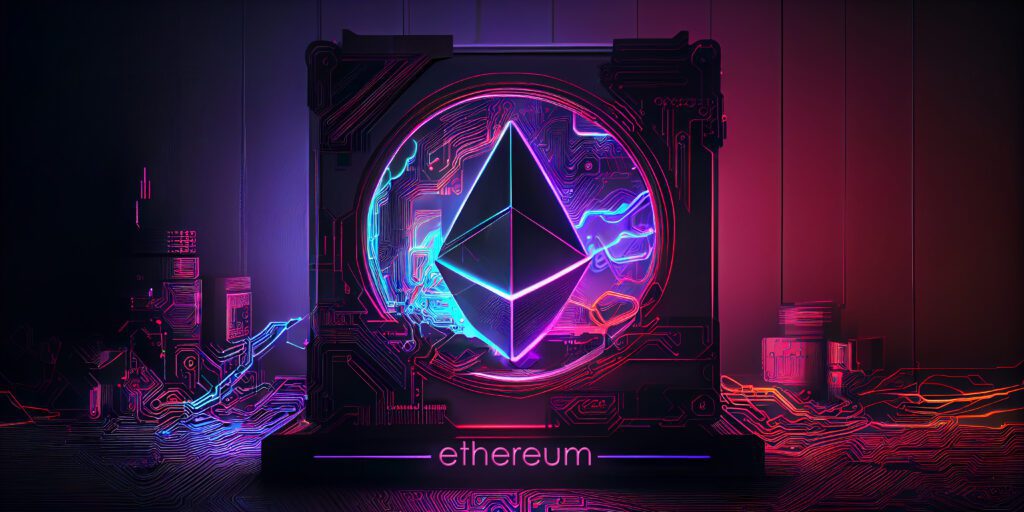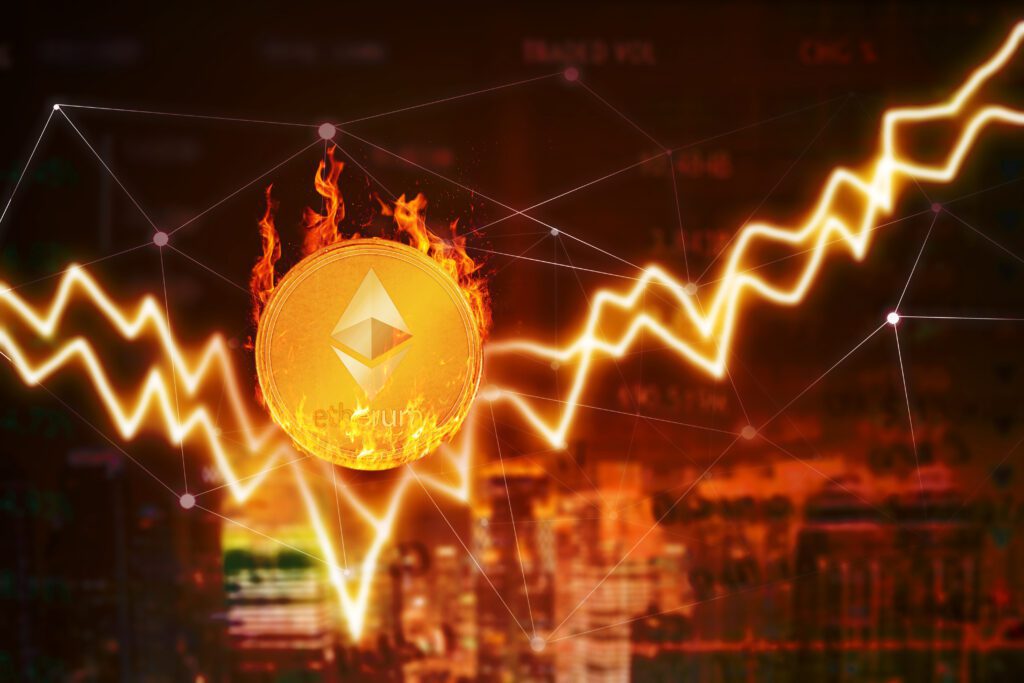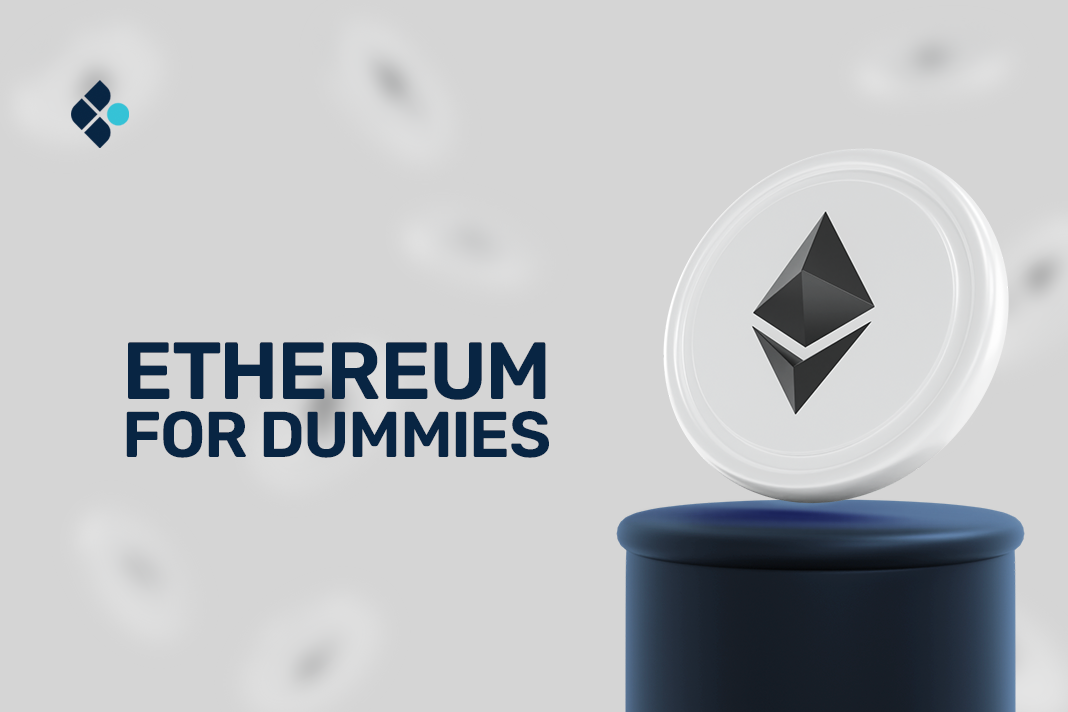Ethereum is the second of the top two cryptocurrencies today. It is the most valued and sought-after crypto, following Bitcoin, accounting for about 20% of the $1.1 trillion global crypto market.
You may have heard of Ethereum, the cryptocurrency, but it is so much more than that.
Ethereum is a highly innovative crypto – however, many crypto enthusiasts underutilize it. Its rapid growth has many people playing catch up, but that’s not going to be you.
In this article, we dive deep into Ethereum, giving you the easy-to-understand breakdown you need, especially for newbies.
Ready to be enlightened? Keep reading!
What is Ethereum?
Ethereum is a computing network built with blockchain technology and equipped with the functionality to build other digital technologies without the control of a central authority.
In our traditional society, most institutions are controlled by a central entity, leaving us at the mercy of their policies and regulations.
Ethereum aims to eliminate intermediaries interfering with our autonomy. We can see that with Ether (ETH), its native coin used to transact on the blockchain. With ETH, you can choose the shun the banking system and gain complete control of your finances.
However, Ethereum’s usefulness extends beyond finances.
Ethereum is open-source and allows the smooth running of the technologies developed on the Ethereum network. These solutions are smart contracts, decentralized finance, games, NFTs, etc.
Ethereum is scalable, programmable, secure, and decentralized. So, most developers and innovators choose to build Web3 solutions on the Ethereum network because of those qualities.
Ethereum’s vision is beyond a secure payment system or asset management. Ethereum is exploring the full potential of the blockchain and how it can make our world safer and decentralized.
How Did Ethereum Come To Be? The History Of Ethereum Blockchain
Ethereum has the advantage of being the second cryptocurrency that came into the scene. It built on the foundation of Bitcoin and has explored and implemented innovative concepts foreign to blockchain technology at the time.
In November 2013, Vitalik Buterin published the idea of Ethereum in a whitepaper. Intrigued by Vitalik’s view, some brilliant individuals joined as co-founders. They include; Gavin Wood, Charles Hoskinson, Amir Chetrit, Anthony Di Iorio, Jeffrey Wilcke, Joseph Lubin, and Mihai Alisie. Together, these people brought Ethereum to life.
In 2014, Vitalik presented the Ethereum blockchain project at a Bitcoin conference in Miami, Florida. Later that same year, the project raised its capital by exchanging ETH for millions of dollars. This capital was used to execute the Ethereum blockchain.
Even though ETH has been up for sale since 2014, investors had to wait until the launch of the blockchain in July 2015 before ETH could be used.
The Ethereum Blockchain Levels of Evolution
Even though the Ethereum blockchain was open to the public in July 2015, its unraveling and progression took some time to become what it is today.
The first stage was called FRONTIER. It launched two things:
- hosting smart contracts and
- equipping interested parties with the tools they need to mine ETH. Ethereum, like Bitcoin, used the Proof of Work (PoW) mechanism.
Since the Frontier, Ethereum has gone through other stages, like the Byzantium, Constantinople, and Beacon Chain. Each level has modified some aspects of the blockchain.
Ethereum underwent a hard fork in the Byzantium stage, splitting the blockchain into two in 2017. This stage was critical to the blockchain as it activated faster transactions and more robust security and made smart contracts suitable for businesses.
In 2019, Constantinople took place. This was also a hard fork update to sort out the cost, speed, functionality, and some challenges faced by miners.
The Beacon Chain in 2020 was a big thing in the crypto world. It launched the Ethereum 2.0 blockchain. This blockchain uses a different consensus system — the Proof-of-Stake (PoS).
The Beacon Chain was responsible for:
- coordinating the PoS mechanism;
- creating new blocks;
- validating new blocks and ensuring the validators are rewarded.
The Beacon Chain fixed some of the flaws of the Proof of Work mechanism, such as accessibility, scalability, and centralization.
Ethereum has continued progressing and rolling out innovations to improve the blockchain. It is not perfect, but it is still growing, and hope holds out for the future of this blockchain.
How Does The Ethereum Blockchain Work?
Ethereum is decentralized in the very sense of the word. That is – no company, entity, or authority controls it. Instead, several codes power the blockchain. Like a complex puzzle, many pieces come together to confirm its functionality.

As we have established, Ethereum is not limited to finances. It paved the way for many unique technologies we now enjoy. So, what are the inner workings of Ethereum?
Smart Contracts
You cannot talk about Ethereum without mentioning smart contracts. The principle on which this was founded is quite simple.
Imagine you want to execute a project. You would usually go through the process of signing contracts with your contracted employees, right? In this contract, you would state your terms, expectations, and the amount to be paid.
But, in the case of smart contracts, codes will be written, and your contract will only be executed if the terms have been met. This allows you to digitize the process and program the agreement to self-execute only when all the stipulations have been met.
Smart contracts express the decentralized nature of the Ethereum blockchain, as they eliminate the need for intermediaries. So, it is a trustless system where there is no need to rely on the integrity of the third party.
Please note that smart contracts are open to all cryptocurrencies and not restricted to Ethereum.
Ethereum Blockchain
Ethereum blockchain is a computer network communicating and storing data. Therefore, before any smart contract is executed, thousands of computers must confirm that the stipulations have been met.
These computers are called nodes in blockchain lingo. These nodes store a copy of the entire blockchain. See how one entity doesn’t control the system now?
These nodes store; transaction details, transaction history, accounts, smart contract codes, and agreements. All nodes must follow the same rules and are all connected.
Ether
So, we know that this is the native currency in the Ethereum blockchain. It is used for all transactions in the blockchain.
Ether is usually stored in accounts. There are two types of accounts.
- Externally Owned Accounts (EOA); typical users use this to hold and send ETH
- Contract Accounts store smart contracts.
Proof of Stake Consensus Mechanism
In 2022, Ethereum transitioned into a new consensus system during “The Merge.” This moved the blockchain from a Proof of Work to a Proof of Stake mechanism.
PoS required users to deposit and lock away 32 ETH to become network validators. This eliminated the need for heavy-duty processing computers.
PoS encouraged more people to become network validators and cut back on the emitted energy by 99.95%.
The Ethereum Virtual Machine (EVM)
EVM is Ethereum’s native processor that converts smart contracts from human to machine language. A programming language called Solidity is used to write smart contracts. However, machines don’t understand it, so it is translated into low-level machine languages called opcodes to be efficiently executed. EVM can run over 150 opcodes.
What Is The Difference Between Ethereum And Bitcoin?
Even though Bitcoin was the foundation on which Ethereum was built, they are NOT very similar cryptocurrencies. They are digital currencies that remove third-party interference, but that’s where their similarities end.
Here are some of the ways they differ:
- Use-case
The primary aim of Bitcoin is to replace traditional money and be used as a means of value storage and exchange, but it goes beyond that with Ethereum. Ethereum is meant to power solutions on the blockchain.
Ethereum can be programmed, and decentralized applications are built on its blockchain. So, ETH powers the transactions of these smart contracts, decentralized apps, and other solutions that can be developed. Also, ETH can be traded as crypto on exchanges, acquired as an investment asset, and as a currency to purchase goods and services.
- Consensus mechanism
Bitcoin uses the PoW mechanism, but Ethereum migrated to the less energy-consuming, Proof of Stake mechanism.
- Block Time and Block Limit
For miners/validators to confirm a transaction and verify block creation, it takes 10 minutes for Bitcoin and an average of 14 to 15 seconds for Ethereum. The maximum limit for a block is 1MB on Bitcoin and limitless on Ethereum.
What Is The Ethereum Blockchain Used For?
There are so many things you can do with Ethereum. It has enough space to fit regular users, developers, and enterprises. Let’s look at how Ethereum can benefit you.
1. Financial transactions
Like regular cryptocurrencies, you can use ETH to carry out different types of transactions, trade ETH on exchanges, buy goods and services, etc.
2. Smart contracts
Rather than relying on intermediaries to help you actualize an agreement, you can use smart contracts on the Ethereum blockchain to ensure that your agreements are followed to the letter.
3. Non-Fungible Tokens (NFTs)
Assets can be tokenized digitally. This means they are turned into a digital representation of a valuable asset. These tokens are unique, and once you buy them, you get complete ownership. They are called NFTs.
All asset types, from luxury items to art, music, and tickets, can be tokenized as NFTs using the Ethereum blockchain. You can also trade these NFTs and transfer ownership to others.
4. Gaming
The Ethereum blockchain also supports the development of games and virtual worlds. The gaming world is rapidly growing, and lands, characters, and gaming assets can be tokenized and owned.
5. Decentralized Finance (DeFi)
As the name suggests, DeFi is a finance system built on the Ethereum blockchain without a central unit. It is a network of financial applications that enables developers to be innovative. DeFi explores advanced trading methods, payments, investments, and money lending.
Should I Invest in Ethereum? Is Ethereum a Good Investment for Beginners?
This decision is entirely up to you. First, you need to consider your investment objectives, goals, and how much risk you are willing to take.
You must know that the value of Ethereum is speculative, and the crypto market is highly volatile. However, solutions are continuously being built on the Ethereum blockchain, thus, increasing Ether’s demand and value.

In crypto, the rule of thumb is to invest small fractions into crypto and diversify your portfolio. This way, you are shielded from unfavorable markets, and the risks are bearable.
Here are some pointers that can help you make informed investment decisions.
Pros of Ethereum
- Wide range of functionalities: Many things can be achieved on the Ethereum blockchain. It extends beyond trading, and this, in turn, causes ETH to increase in value.
- Extensive network: Ethereum is the largest blockchain ecosystem, with significant community members committed to the blockchain.
- Private Internet: If you value privacy, you are not required to put all your personal information on the network.
- Security: the PoS mechanism ensures that your transactions are not tampered with.
- Consistent network improvement: There is a steady flow of innovative applications and updates on the blockchain. This draws more people to the ecosystem due to the introduction of new and exciting solutions.
Cons of Ethereum
- Unlimited crypto supply: Because there is no limit to the available Ether, it may not climb as high in value as Bitcoin. Limited supply drives up value, while the unlimited supply of ETH may cause the coin to function more like Dollars than Bitcoin.
- Increased transaction costs: Ethereum’s popularity is a double-edged sword because it also causes transaction fees to increase. This may work well for network validators, but these “gas fees” aren’t favorable to regular users.
How To Safely Buy Ether
Buying Ether is very straightforward. The first step is choosing a safe exchange platform. Some options include; Kraken, Gemini, Binance, etc.
Next, you’d want to link your credit or debit bank to buy Ether (this is not available to Nigerians). Alternatively, you can buy through peer-to-peer transactions.
Each exchange has its procedure, and you would be provided tips and pointers specific to that exchange.
How To Store Ether
Most exchanges are custodial wallets. However, be careful not to store large amounts of ETH on these exchanges. These custodial wallets are called Hot Wallets because the private keys are kept with the exchanges. So, if anything happens to the exchange, you risk losing your ETH.
Cold Wallets are safer options because they’re not connected to the internet. You can generate private keys on certain websites to open your cold wallet.
How To Sell Ether
There are specific criteria your chosen exchange should meet before selling your ETH. These checks are; Security, Exchange Rates, and Transaction Processing Time.
Breet is a trading app that fulfills all these requirements and more. With Breet, traders in Nigeria and Ghana can expect a seamless transaction when exchanging ETH for cash. This one-in-all trading app offers swift payouts, standard security measures, and competitive rates. With Breet, you can trade your ETH in minutes and automatically send your cash to your local bank account.
Want to see for yourself? Set up an account with Breet to join our community and enjoy these benefits + more today!
Frequently Asked Questions (FAQs)
How Many Ethereum Are Left?
There is a lifetime supply of Ethereum. However, 180 million ETH are released every year. Currently, roughly 120.23 million ETH are in circulation.
Is It Better To Buy Bitcoin Or Ethereum?
Bitcoin and Ethereum are the two most prominent players in crypto. They both have their appeal and usefulness. But, before you invest in any, it’s essential to do your research. You can check out this complete exposition on Bitcoin before deciding.
Can Ethereum Be Converted To Cash?
Yes. You can exchange your ETH for cash. Exchanges like Breet offer the most secure, user-friendly trading experience with the juiciest exchange rates. Breet can automatically convert ETH to Naira or Cedis, and in no time, you’d have the cash in your bank account.
Is It Too Late To Buy Bitcoin And Ethereum?
It is not late at all to buy Bitcoin or Ether. You can easily invest in these coins, even with as little as $1. You don’t have to buy the whole currency because owning fractions of the cryptocurrencies is possible.
What Is Ethereum 2.0?
In 2020, Ethereum 2.0 emerged in the Beacon Chain update when the consensus mechanism was changed from Proof-of-Work (PoW) to Proof-of-Stake (PoS).
This resulted in Ethereum operating on duplicate blockchains. The preexisting blockchain was called the Ethereum Mainnet, and the newer update was Ethereum 2.0.
The Beacon Chain update sought to improve some challenges on the Ethereum Mainnet. The primary challenge was the energy-intensive mechanism, PoW. The PoS was a more sustainable energy alternative as it reduced carbon emissions by 99.95%.
However, in September 2022, in a process called ‘The Merge,’ the Ethereum Mainnet and Ethereum 2.0 became one, and the blockchain was simply called – Ethereum. Thereby upgrading the network from a PoW to a PoS mechanism.
What Is The Future Of Ethereum?
Even though knowing what the future holds is impossible, Ethereum is one of the most promising cryptocurrencies. We can see this in the market capitalization, its growing popularity/adoption, and its wide range of functionalities.
ETH powers the Ethereum blockchain, and from all indications, it will continue to see a value increase.
Conclusion
Congratulations! You’ve demystified Ethereum. You’re now armed with in-depth knowledge of Ethereum, its inner workings, progressions, purpose, and use cases. You can now make informed decisions on building on the network, buying, storing, and selling ETH.
You’ve also discovered Breet, the best trading platform to sell your ETH in exchange for Naira or Cedis. Breet is the easiest way to get instant cash for your ETH – now, why don’t you go open an account and see what the hype is about?
